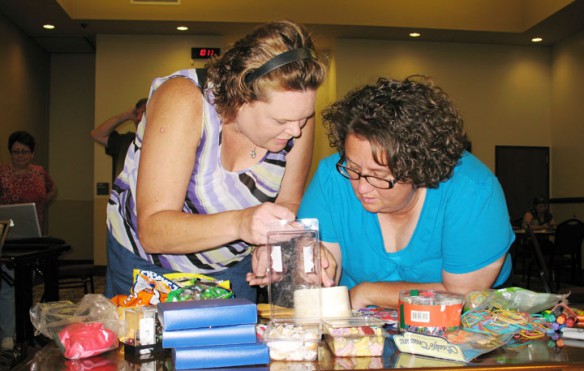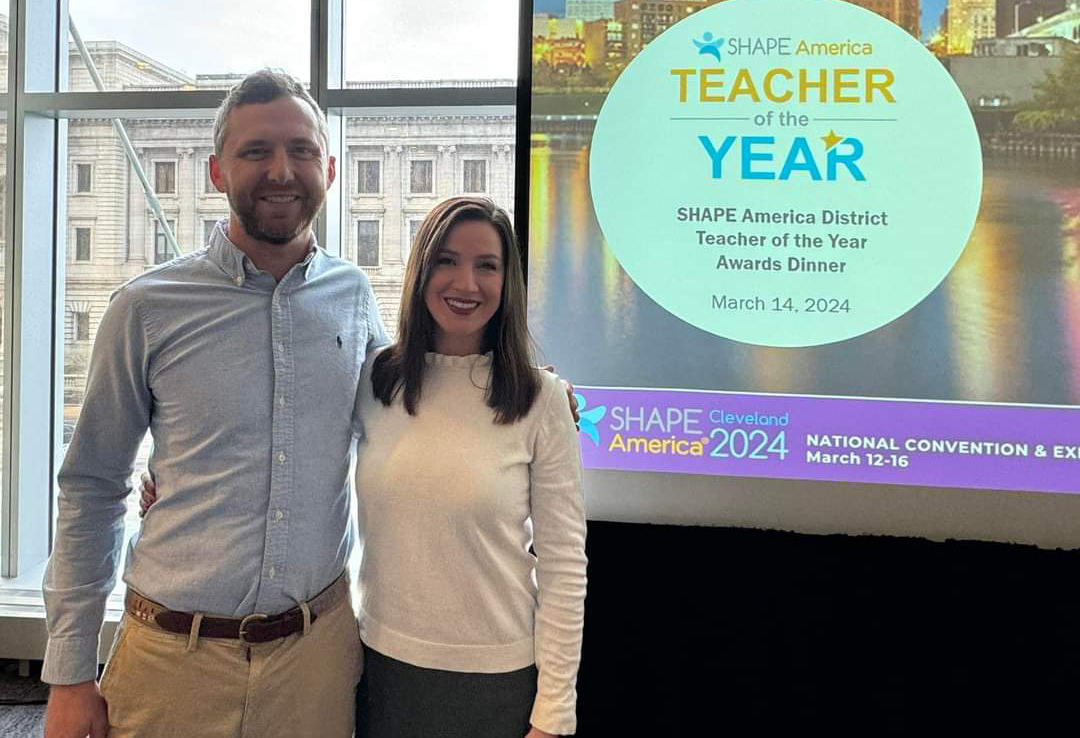
Cheryl Diamond, a 5th-grade teacher at William Wells Brown Elementary School (Fayette County), and Jenna Gray, computer instructional technology teacher at Bowling Middle School (Owen County), look over letter tiles and other items on the supplies table to help make the paper prototype of their game at the Game Design Jam at Elkhorn Crossing School in Scott County. Photo by Matthew Tungate, July 11, 2012
By Matthew Tungate
matthew.tungate@education.ky.gov
Last school year, students in the Student Technology Leadership Program (STLP) at Bowling Middle School (Owen County) programmed some basic computer games, but Jenna Gray thought they didn’t have much substance or applicability to the classroom. The instructional technology teacher and STLP coordinator knew there had to be more to game design than just the programming.
Gray and 11 other teachers found out just how right she was earlier this month when they participated in a three-day professional development that taught them how to develop coaching strategies that can be used to guide students through research and creative game-design processes.
During that time, Gray and three other teachers designed “Transtopia,” a number sense and basic mathematics game where players have to discover what is wrong in various villages and correct the problems. Gray said each member of the team used her own interest and skills to complete the game. Gray worked on making sure parts of the game were designed in correct proportion to one another.
“I was doing so much math, and nobody told me to do that. It’s just what lent itself to the project,” she said.
Students would have practiced more than math had they designed the game, Gray said.
“It applies to every single piece of content, but at the same time you’re getting so much writing in. You have to write all this stuff down,” she said. “And they’re not copying and pasting; they’re writing it in their own words without you forcing them to write.”
Gray regularly has her students work on proportions and scale drawings, and she thinks having them design a game is a good way to learn them.
“I think this lends itself to more creativity for the kids, things they’re interested in and invested in, but at the same time the teachers are going to get the content they’re wanting,” she said.
Getting teachers to understand that they can use game design to teach students important concepts in a more meaningful, yet fun, way was the purpose of the state’s first Game Design Jam, according to Keith Barnes, technology integration specialist for secondary schools in the Bullitt County school district.
The Game Design Jam, held at Elkhorn Crossing School in Scott County, grew out of a Hewlett Packard Catalyst Initiative grant won by the state STLP, the Learning Games Network and the Digital Game-Based Learning Lab of the P20 Innovation Lab at the University of Kentucky.
“The project for this two-year grant is to see if having students design games related to their learning targets can enhance STEM education,” Barnes said.
Seeing how game design can help students learn is difficult even though teachers have access to online tools and webinars, said Alex Chisholm, executive director and co-founder of the Learning Games Network, a non-profit spin-off of the MIT Education Arcade and University of Wisconsin-Madison’s Games+Learning+Society Program that seeks to bridge the gap between research and practice in game-based education. That’s why he and Barnes developed the idea for face-to-face professional development.
Chisholm said the Learning Games Network will release a free toolkit for teachers Aug. 1. The toolkit has a handbook with lesson guides, strategies and online videos, and the organization is developing a tablet application he hopes will be included, Chisholm said.
“Games are a medium that have incredible potential to support what teachers are already trying to do in the classroom, but with a powerful 21st-century digital structure,” Chisholm said. “We see games as a really powerful tool that teachers can use as part of the classroom ecosystem.”
The games can be designed as computer games or as board games. The finished product is less important than the research, critical thinking and application of knowledge that goes into designing the game, he said.
“Our aim is really to use game design in service of the learning,” he said.
During the Game Design Jam, Barnes and Chisholm had teams of teachers develop paper prototypes of games that would teach students something. Teachers had to think as a player and consider all scenarios they would go through to reach their goal.
Barnes said one of teachers’ biggest barriers to using game design in the classroom is not knowing computer-programming software. By limiting the games to paper prototypes, that is not an issue.
“It’s not a technical thing at all, he said. “This is language arts, this is social studies. It doesn’t matter what you teach.”
Cheryl Diamond, a 5th-grade teacher and STLP coordinator at William Wells Brown Elementary (Fayette County), said she was worried about not knowing how to program games before attending, but she never used a computer while she was there.
Using game design is not really even about computers, she said.
“There’s a lot more in-depth to the design and researching than I realized,” Diamond said. “This idea is about letting go of a teacher-centered learning experience and allowing the children to explore and learn the content in a more meaningful way. It’s all paper-based group work and collaboration, but more importantly, the students are retaining and using the information instead of the teacher lecturing about a topic.”
After attending the Game Design Jam, Diamond said she has a better idea how school topics and games connect.
“It’s better for them to have a stake in the content and to know how to apply it then for me to do the research. I’m working harder and students are not relating content to what they know, when really I need to work smarter and let the kids do it so they take ownership of the work,” she said. “They’re the ones researching and figuring out how to apply it to a game, so it’s better than lecturing and giving them 10 problems with very little retention.”
Jessica Beasley, STLP co-coordinator, and gifted and talented and career and technology teacher at Anderson County Middle School, said students are natural gamers, so having them design games won’t seem like work.
“If kids are having fun doing something, they’re going to learn, and they may not even realize they are learning,” she said. “They already like gaming, and they’ll sit for hours playing a game. So why not try to combine the two? If you can make it to where they’re learning and they don’t realize they’re learning, even better.”
Beasley has some STLP students who work independently, and some of them have expressed an interest in making a game or a phone or tablet application. She said she might have those students work with a teacher in an academic area where students struggle. Her students would do the research, and then figure out how to make the subjects interesting through game design.
“There’s a lot of learning going on for the kids just making a game,” she said.
MORE INFO …
Keith Barnes, keith.barnes@bullitt.kyschools.us, (502) 869-8047



Leave A Comment